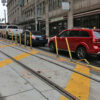As a response to the Central Business District congestion pricing plan by the city of New York to eventually charge a new toll on motorists who enter lower Manhattan, two members of the House of Representatives of the United States — both of whom represent congressional districts in New Jersey — are advocating that the subway in New York should extend to New Jersey.
Should Subway in New York Extend to New Jersey?

“While we have deep reservations about the Program, we support expanding MTA’s 7 Train to New Jersey. This expansion would provide a single-seat option for New Jersey residents commuting into Manhattan while meeting the Program’s stated purpose of reducing the number of cars traveling into the CBD”, according to this letter that was sent to Janno Lieber of the Traffic Mobility Review Board of the Metropolitan Transportation Authority on Thursday, September 28, 2023 by Bill Pascrell and Rob Menendez. They are urging the Metropolitan Transportation Authority to bundle the aforementioned congestion pricing plan with the extension of the 7 train line to Secaucus via a new subway tunnel under the Hudson River.
“As it currently stands, the Program will place a significant financial burden on New Jersey residents who commute into Manhattan. It is estimated that the average commuter could pay an additional $5,000 tax per year, allowing the MTA to reap this additional revenue without investing in pollution mitigation in New Jersey or improved public transit services for our residents. As New Jerseyans return to in-person work, we should take steps to make their commutes easier, more efficient, and more affordable in the most environmentally friendly way possible”, according to the aforementioned letter. “Further, under the Program, the Port Authority of New York and New Jersey (‘PANYNJ’) stands to lose millions of dollars every year, which will significantly limit its ability to improve critical assets, such as the Port Authority Trans Hudson (‘PATH’) service between New Jersey and New York, and the proposed redevelopment of the PANYNJ Midtown Bus Terminal. If the MTA and New York City are serious about alleviating congestion, it should improve public transportation by expanding the reach of their services and ridership through additional rapid transit options across the Hudson River.”
A feasibility study for the city of New York that was prepared by Parsons Brinckerhoff and published in April of 2013 evaluated extending the 7 train line via a tunnel with two tracks under the Hudson River. The study found that an extension to the Frank R. Lautenberg Station in Secaucus would improve access across the Hudson River between New York and New Jersey by leveraging existing investments in the extension of the 7 train line — which is also known as the Flushing Line — and allow for an estimated rider capacity of 128,000 people per day. In addition, the study found that the 7 train line extension would be fully compatible with the Gateway Project, which was recently confirmed with staff at the Gateway Development Commission.
A significant number of politicians who represent constituents in New Jersey — including Philip Murphy, who is the current governor of that state — vehemently oppose the Central Business District congestion pricing plan in New York. “Despite significant opposition to the Central Business District (‘CBD’) Tolling Program (‘Program’) and the unique and disproportionate impacts the Program will have on New Jersey residents, the Metropolitan Transportation Authority (‘MTA’) has shown no interest in engaging in a good-faith dialogue with key stakeholders in New Jersey”, according to the aforementioned letter. “The Program must be affordable for New Jerseyans and be accompanied by the extension of the subway system’s 7 Train to Secaucus Junction, with appropriate labor safeguards in place.”
Final Boarding Call

I used to be a passenger on the Port Authority Trans Hudson trains between New York and New Jersey — as well as between West 33 Street and Christopher Street in Manhattan — as at one time the fare was approximately half of the fare that was charged on the subway lines by the Metropolitan Transportation Authority. It is a viable transportation alternative to commuter trains; but its network is limited.
The current fare for the Port Authority Trans Hudson trains is $2.75; whereas the current fare for the subway is $2.90. — so riding between West 33 Street and Christopher Street in Manhattan will save you 15 cents.
The extension of the subway system in New York into New Jersey would provide significant benefits for many passengers, in my opinion:
- Fewer motor vehicles on the roads and in the city of New York
- Less pollution
- Greater accessibility
- More friendly to the environment overall
- Faster transportation options
The downside, of course, is the billions of dollars that would be required to complete the project.
Also, why stop at the 7 train line, which has been extended to West 34 Street and 11 Avenue by Hudson Yards on Sunday, September 13, 2015? Perhaps consider extensions of the L train line and A train line into various parts of New Jersey as well — with easy access to new garages in New Jersey that can accommodate an ample amount of parked motor vehicles while drivers and their passengers can enjoy a quick commute into the city of New York.
Now, if only subway service can be extended to LaGuardia Airport, that would arguably be more convenient than current transportation options…
All photographs ©2014 and ©2022 by Brian Cohen.

